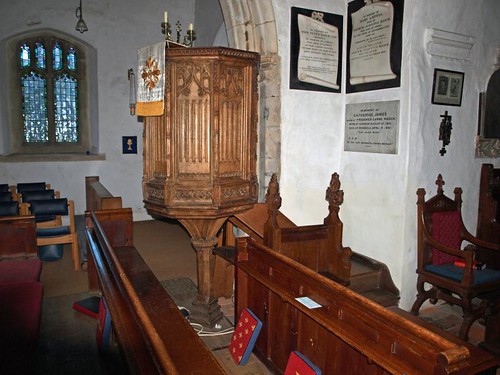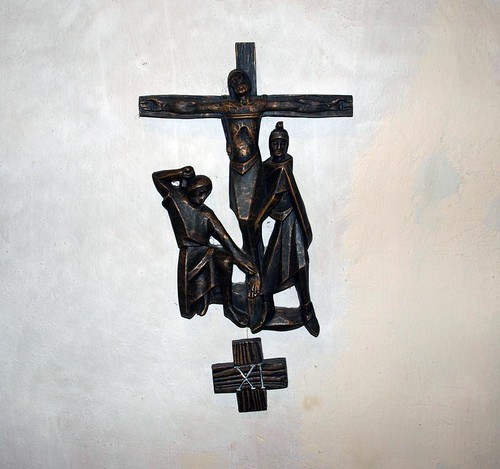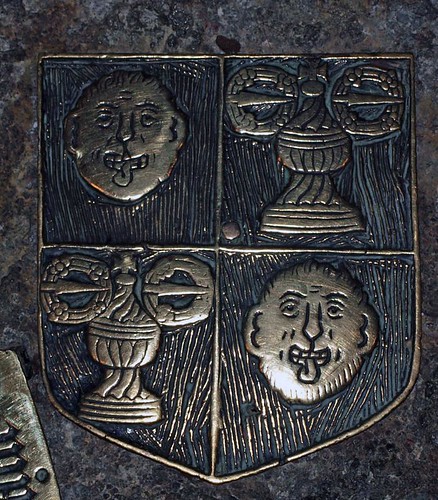The ultra modern Stations of the Cross, which I really liked, mark this out as a high church and whilst not terribly exciting it is architecturally pleasing and the location is stunning.
Apart from a couple of brasses the gem here is the C15th pulpit with its original foot and stem.
ST ANDREW. Nave and chancel Norman, see the remains of Roman brick quoins, also W of the chancel E end which is a Perp addition. The N aisle was built in the C14, as is shown by the three-bay arcade. This has semi-polygonal shafts to the nave and semicircular ones to the arches - all with capitals. The arches have two quadrant mouldings. Early in the C16, in the favourite Essex fashion, the W tower and S porch were erected in brick, red with diaperwork of blue bricks. The tower has a much higher polygonal stair-turret. Both are crowned by battlements. The tower in addition has a little brick dome. The brick W window is of three lights. The porch is distinguished by a rib-vault and stepped battlements on a trefoiled corbel frieze. - PULPIT. A fine, not at all showy, C15 piece. Its foot and stem are preserved, which is rare. The stem is a polygonal pier and the connexion to the pulpit proper is trumpet-shaped. Simply traceried panels. - PAX. The church possesses a C15 Pax, that is a small board for the Kiss of Peace to be given at services. On one side is a painted Crucifixion. The Pax, one of very few surviving, is on loan at the Victoria and Albert Museum. - PLATE. Flagon of 1624; Cup and Paten of 1628. - BRASS to Patrick Fearne d. 1588, with kneeling figures.*
* According to the Essex Arch. Soc. Tram. vol. 22, p. 67, the late Mrs Esdaile has recognized Epiphanius Evesham as the sculptor of a MONUMENT in the church. I cannot see what monument she can have meant.
SANDON. It has a lovely oak of Old England on its green and a handsome brick tower built when Cardinal Wolsey was lord of the manor. Under its battlements is a row of small arches. There are Roman tiles in the walls, and in the chancel a gem of stone carved by a craftsman who may have come over with the Conqueror. For hundreds of years it lay hid in a buttress, a pillar piscina with beading and fluting carved in spirals round the shaft and beautiful ornament on the hollow capital. A veritable treasure is the medieval pulpit, standing ten feet high on a trumpet-like base of carved wood. It has eight sides with traceried heads and linenfold panels; it has also little buttresses and pinnacled corners. A rich window glows through the tower arch, showing the Madonna attended by angels.
In this pulpit preached a famous scholar who was chaplain to Charles Stuart and lost his living for his loyalty. He was Brian Walton, who gave his leisure to making what is known as the Polyglot Bible in seven languages, a work which cost £8000 to publish. A tablet by his pulpit tells of the death of his wife, and on the wall is a record of a rector of Armada year - a brass of Patrick Fearne and his wife, he kneeling by a table, she wearing a wide-brimmed hat.
But the rarest possession of the church is a medieval wooden pax, a ceremonial tablet such as is mentioned by Chaucer. Our museums have a few examples but otherwise they are extremely rare.
Simon K -
Open. This is another stunner, a red brick tower attached to a red brick church, beautiful in the sunshine. The sign said 'our historic church is open from 10am every day', but probably because of the lovely weather the opener had already been. A lot of people seem to like this church, though I found the interior a little over restored for my tastes. There is what looks like a fabulous window by one of the Bromsgrove Guild below the tower, but it is unfortunately blocked off by the organ loft, and I couldn't photograph it. One rare medieval survival is a wine glass pulpit.
I sat in the sunshine in the churchyard and ate my breakfast. James Bettley in the revised Pevsner says 'the church stands in an immaculate churchyard with a green on the east side, and would present a perfect village scene were it not for the A12 on one side and power lines on the other.' Actually, it's better than that - although this is still suburbia, the old village is isolated by the town planners to still feel like a village, and you can't see the power lines or the A12 from the churchyard. But the noise of that traffic! My goodness! The A12 is in a cutting here, but as I crossed it heading east the roar rose, and it was a relief to escape into tiny, leafy lanes, leaving the noise behind, leaving Chelmsford suburbia at last.
In this pulpit preached a famous scholar who was chaplain to Charles Stuart and lost his living for his loyalty. He was Brian Walton, who gave his leisure to making what is known as the Polyglot Bible in seven languages, a work which cost £8000 to publish. A tablet by his pulpit tells of the death of his wife, and on the wall is a record of a rector of Armada year - a brass of Patrick Fearne and his wife, he kneeling by a table, she wearing a wide-brimmed hat.
But the rarest possession of the church is a medieval wooden pax, a ceremonial tablet such as is mentioned by Chaucer. Our museums have a few examples but otherwise they are extremely rare.
Simon K -
Open. This is another stunner, a red brick tower attached to a red brick church, beautiful in the sunshine. The sign said 'our historic church is open from 10am every day', but probably because of the lovely weather the opener had already been. A lot of people seem to like this church, though I found the interior a little over restored for my tastes. There is what looks like a fabulous window by one of the Bromsgrove Guild below the tower, but it is unfortunately blocked off by the organ loft, and I couldn't photograph it. One rare medieval survival is a wine glass pulpit.
I sat in the sunshine in the churchyard and ate my breakfast. James Bettley in the revised Pevsner says 'the church stands in an immaculate churchyard with a green on the east side, and would present a perfect village scene were it not for the A12 on one side and power lines on the other.' Actually, it's better than that - although this is still suburbia, the old village is isolated by the town planners to still feel like a village, and you can't see the power lines or the A12 from the churchyard. But the noise of that traffic! My goodness! The A12 is in a cutting here, but as I crossed it heading east the roar rose, and it was a relief to escape into tiny, leafy lanes, leaving the noise behind, leaving Chelmsford suburbia at last.



I had bad luck here today. I was met by a notice which read "Church closed today"
ReplyDeleteAccording to the response I had from the churchwardens was that there have been a spate of thefts in the area and the church had been targeted.
ReplyDeleteThat's a real shame as it was very welcoming when I visited.
ReplyDeleteIt still had the "This church is open from 10 a.m. to dusk" notices on the churchyard gate and in the porch, and then I became crestfallen when I saw "The church is closed today" notice, and even more crestfallen when I found out why.
Delete